Impossible to Learn
Mandarin Chinese has a reputation for being extremely difficult for westerners to learn.
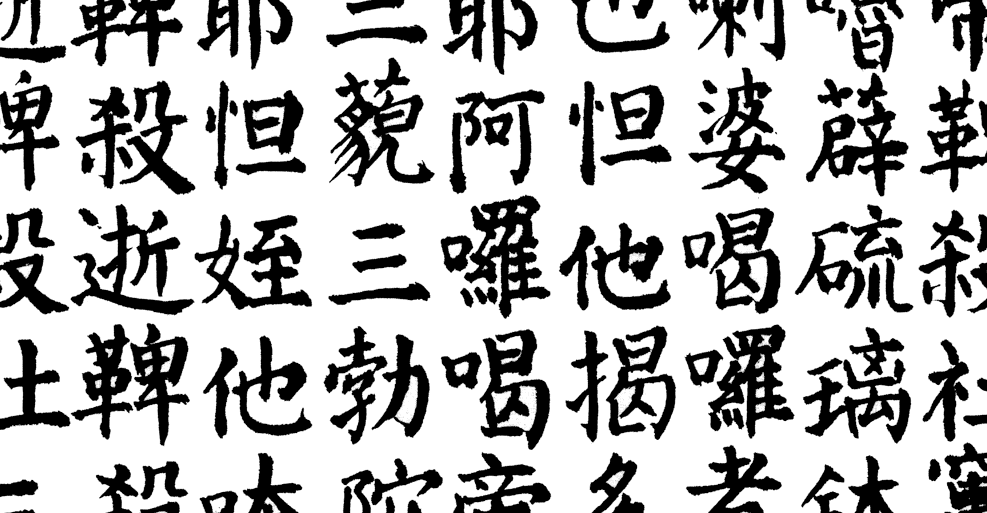
Image source: PRChinese
It’s a not an undeserved reputation. The writing system is obscure, with thousands of different characters, and there’s no way to learn them except through memorization. The language is tonal, which means that depending on the contours of the pitch of your voice, a single syllable can have many vastly different meanings. And there’s a massive cultural gap between the east and west, meaning that the idioms that Chinese people spout—most of which have root in old folk tales, literature, and history—are going to be incomprehensible to a westerner. Put all this together, and you end up with a language that presents massive barriers to adoption for people on this side of the planet.
But what if you decided to try anyway?
That’s what I did for much of last year. I didn’t commit too many resources to it: I did it in a relatively small share of my spare time, and spent little to no money on the pursuit. But by now, although I’m far from fluent, I’ve achieved a good enough understanding of the basics of the language—both spoken and written—that if I were to travel to Beijing tomorrow I think I’d be okay getting my way around.
And although it was difficult, it most certainly wasn’t impossible. In fact, in the Internet Age, the idea that something like this is “impossible to learn” is damaging and artificially limiting. If you’re able to read this article, your access to knowledge, culture, and learning resources is at a level that is completely unmatched throughout history. All you have to do is harness it.
I want to again take you through the barriers to learning Mandarin that I listed above, but this time with a more positive outlook, showing you how I used the resources at my disposal to work around them.
Learning to read
This is the big one. The one that frightens most people off of the very idea of learning Chinese. You see something like “我会说汉语”, and you don’t even know where to begin. How are you supposed to memorize thousands of characters?
The answer is, you’re not. At least, not at first.
The trick is to start with a limited vocabulary. That sentence I wrote above? It uses exclusively characters from the HSK 1 vocabulary list, the first of the Chinese government’s six standardized Chinese proficiency tests. It has a vocabulary list of only 150 words. Even just that is enough to understand something like the following conversation:
“对不起,请问学校在哪儿?”
“在那儿。你是学生吗?”
“是。你呢?”
“不是,我是你的老师!”
“对不起!”
“没关系。我很高兴认识你。我是关老师。”
There’s immense power in understanding even a small subset of characters. Once you’ve learned the HSK 1 vocabulary, instead of seeing abstract squiggles, you would instead see something like this:
“Excuse me, where is the school?”
“It’s over there. Are you a student?”
“I am. What about you?”
“I’m not a student, I’m your teacher!”
“I’m sorry!”
“That’s alright. I’m very happy to meet you. I’m Professor Guan.”
Even the next level, the HSK 2, only has 150 more words than the HSK 1, for a total of 300, and by the time you master those you already know enough for some basic casual conversation.
There are other reasons why starting with a small set is useful. First off, once you know a few hundred characters, you get to a point where even if you don’t know all the characters in a sentence, you can often make an educated guess as to what the sentence as a whole means. And once you get past the first few hundred, memorizing the later characters gets easier, because most of the more complex characters are compounds of simpler ones.
Still, though, even a few hundred characters can seem daunting, especially if—like me—you’re someone who often has trouble with memorization. But technology can come to the rescue here, and it can do so in a way that makes it fun and easy.
Enter Memrise.
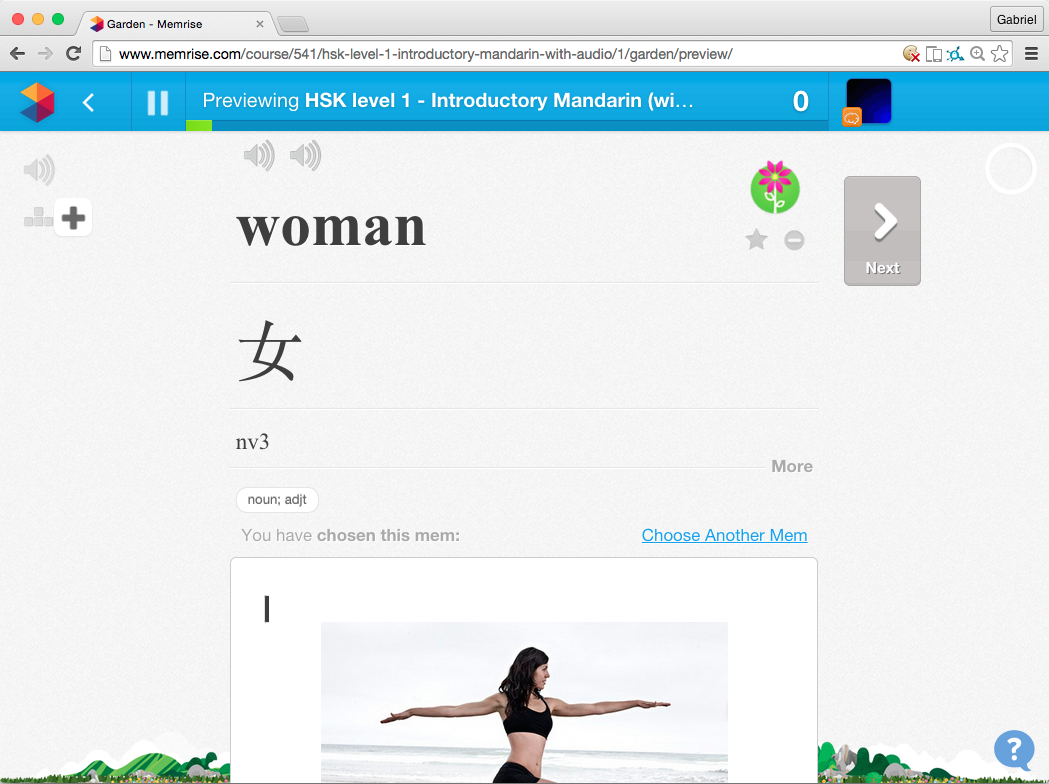
Memrise is a website and a mobile app that helps you learn vocabulary. It’s not going to help with grammar, sentence structure, or anything like that, but it is excellent at helping you memorize pretty much anything, including Chinese characters.
Here’s the way it works:
- They start by teaching you a word or character. For example, let's say they teach you that the character 女 means “woman” or “female”.
You come up with a clever little mnemonic to help you remember that fact, or pick one that someone else has already created. This could be a bit of text, or an image, or even a video. Maybe you notice that the character 女 looks a little like a woman doing yoga:

You can see several of the mnemonics—or “mems”, as they call them—that I’ve created here, and you’ll find a mix of a bunch of different strategies: images with silly captions, etymological background information, or even puns and plays on words. You can use whatever works to make it stick in your head.
They then teach you a handful of other characters, and quiz you a couple of times on all of them.
Then you close the website and forget about it for a while.
Four hours later, the website will say that the 女 character, as well as the other ones you learned along with it, need revision. If you have the mobile app installed, it’ll give you a little notification to remind you.
You pull out your phone or get back on the website, and it’ll quiz you again on the characters you learned.
If you get it wrong, they’ll remind you to review again in another four hours. If you get it right, though, it’ll remind you in twelve hours this time. If you get it right again, it’ll remind you in a day. Then two days, six days, twelve days, and so on. The intervals themselves vary a bit, but as long as you keep passing the quiz, they always increase in duration. By the end of it, the intervals are months long and the character ends up locked into your long-term memory.
This is a technique called spaced repetition, and the effectiveness of this strategy of memorization can’t be overstated. Compared to the way most of us probably tried to memorize things in school—poring over the material in long sessions, repeating it to yourself over and over, and so on—this takes up less time, less effort, and is much more enjoyable. Reviewing sessions take a few minutes at most, and since it’s on your phone, you can do it anywhere. And on top of that, they make it fun, with points awarded for learning, rankings, leaderboards, and so on.
And hey, guess what? They have plenty of pre-built courses on Chinese, the most prominent of which follow the HSK vocabulary lists. And it’s completely free to use.
And if you ever come across a character that you don’t recognize, and haven’t learned yet? Then you have Wiktionary or MDBG or Pleco, the latter of which is one of the best, most versatile apps I have on my phone. And all of those are free.
Learning to write
How about writing? How are you supposed to remember how to draw those things, especially in more complicated characters like 零 or 舞? How are you supposed to develop the accuracy to draw those out with a pen?
Here’s a dirty little secret: you don’t have to. Because you’re in the twenty-first century, you have at least one of a smartphone and a computer, and you don’t have to handwrite things anywhere near as often. Once you’re more familiar with reading and typing the characters, you can start to practice a bit of handwriting. But up until that point, reading and typing will take you very far.
How do you type Chinese on a keyboard? Simple: you type out the pronunciation using roman characters, using pinyin romanization, and then pick the Chinese character you want from a list.
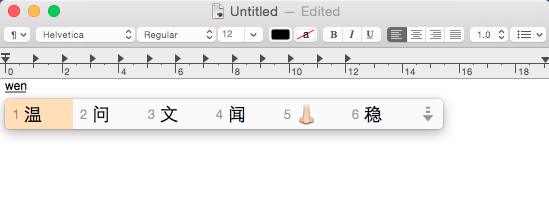
You can even type a whole phrase, and it’ll pick the characters that are most likely given the whole phrase as context.
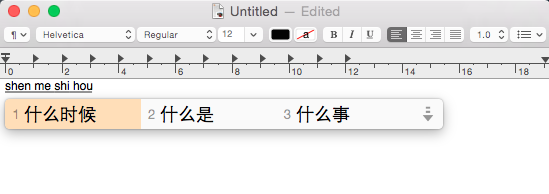
Not only that, but most of these input systems learn from what you type, so that words that you type more frequently show up at the top. This is especially useful when typing out people’s names, as they can often use rare or unusual characters.
What if you don’t know how the character’s pronounced? In that case, at least on mobile phones and Mac laptops, you can use a handwriting input method, and sketch out the character with your finger on the touchscreen or trackpad. It doesn’t have to be accurate or pretty, and it’s very useful for looking up new and unfamiliar characters.
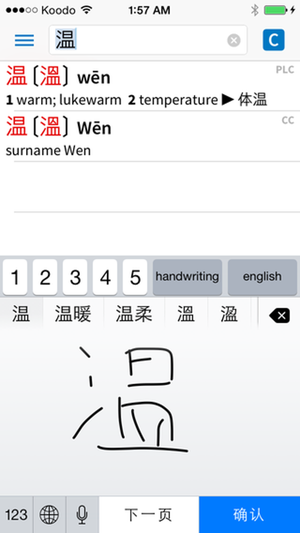
Pictured: my wonderful index-finger calligraphy.
If you have an iPhone, it even comes equipped with Mandarin speech recognition by default. If you want to know how something is written, but you’ve only ever heard it spoken, you can just speak it in a sentence to the phone. As long as you pronounce it clearly enough you’ll get the written representation back out, which is useful in cases where you can’t quite figure out the correct romanization.
Of course, that raises the question: how can you develop good pronunciation?
Learning to speak
One of the best ways to learn how to pronounce things is to listen to them spoken.
Good thing you’re on the internet.
Want to know what the different tones sound like and how to pronounce them?
How about a thorough explanation on the proper pronunciation of some unfamiliar Chinese consonants?
Or maybe you’re the kind of person who prefers a written explanation on these topics, complete with diagrams?

Granted, none of those are really comprehensive lessons. They’ll clear up a few specific topics, things that are typically difficult, but they won’t give you an overall view of the language or help you practice listening and speaking.
But if you’re living in a country like Canada, you probably have a secret weapon available that you might not even be aware of—an institution from before the Internet Age that has become empowered by new technology.

Yep, the library. Compared to online videos, tutorials, and services, a book that you get from the library is going to give a much fuller, much more comprehensive overview. And I’ve used it frequently—it’s how I first learned Flash development, where I first read up on Unity, and it’s one of the first resources I used when I started to learn Chinese.
In this case, I used the Toronto Public Library’s online system to borrow the Pimsleur Language Program audiobook series on Mandarin Chinese, a fantastic series of language-learning audiobooks that teaches pronunciation, grammar, and vocabulary all at once through a series of half-hour lessons that you can take in the comfort of your own home. They also take an approach similar to spaced repetition, gradually teaching you new words while reminding you of older ones periodically, asking you to translate and repeat words, and simulating conversations, and so they have the same benefits that Memrise does.
They would have cost hundreds of dollars if I were to buy them myself, but thanks to the library I was given access to them for free.
But learning pronunciation isn’t really enough to converse with native speakers, is it? You still need to have some cultural awareness, get yourself used to slang and common idioms, and so on. How are you supposed to go about doing that?
Learning to listen
Once again, I tell you: you are on the internet.
You are literally one click away from Chinese websites, encyclopedias, and social networks. You are one click away from communities of language learners where people more knowledgeable than you explain the most confusing of language conventions. You are a google search away from explanations of obscure idioms, customs, and folk tales, or detailed wikis with information on common grammatical constructs.
But of course, jumping into the deep end by trying to read Chinese websites can be a bit overwhelming. Could there be a more gradual way to expose yourself to these things, maybe with someone to explain things to you?
Enter HelloTalk.
Yes, I also find this video to be exceedingly silly.
At its core, HelloTalk is a free messaging app with some features convenient for language learning, like automatic translation, text-to-speech, speech-to-text, the ability to correct sentences, and so on. The key point to it, though, is its ability to connect you with other language learners. You tell it what language you speak natively, and what language you’re looking to learn, and the app will try to connect you to people who are looking to learn your native language. So if, like me, you’re a native English speaker that wants to learn Mandarin, it’ll connect you with native Mandarin speakers who want to learn English. And since HelloTalk is a Chinese-made app, there are a lot of Chinese people wanting to learn English. You will have a lot of choice in language partners, and if you’re lucky, you may even make some good friends. I know I did, and getting to connect with someone from halfway across the world was undeniably the best part of the whole process.
Nothing is impossible
The point of all this is not to tell you how you can learn a new language, or how to learn Chinese. The point is to show you, by example, that something that may seem impossible to learn can be possible if you take advantage of the resources available to you, and to show you just how many resources there are these days, if you just take the time to look for them.
I didn’t know about most of these resources back when I started learning. Aside from my aforementioned affinity for libraries, the only other one that I was even vaguely aware of was Memrise. All of the others I either discovered via a bit of directed research and effort, or found via a combination of serendipity, curiosity, and a willingness to try new things.
What do you want to learn? Is it a new language? Is it how to play a musical instrument? How to program computers? How about typography or graphic design? Maybe some world history? Or some foundations of philosophy? Maybe it’s something more practical, like personal finance or how to write a business plan. Or maybe you just really, really want to learn how to juggle.
Whatever you want to learn, chances are the information is out there. It’s not impossible. You just have to grab hold of it.
As for me, I can never look at Chinatown the same way again.

跟天书不一样